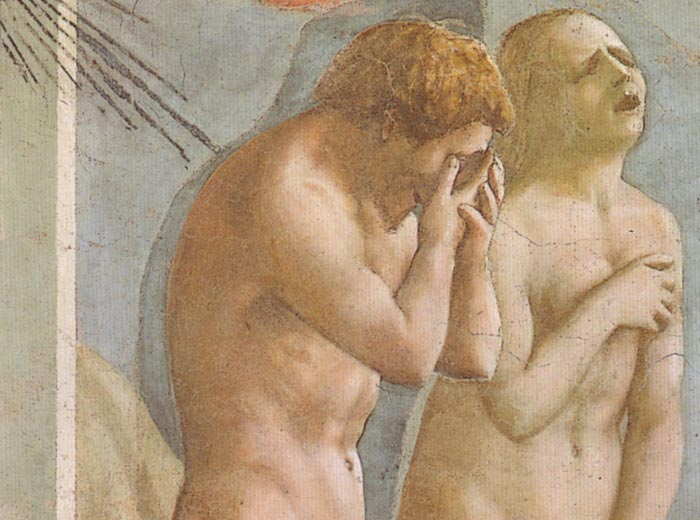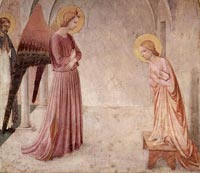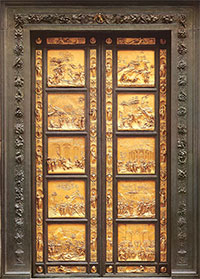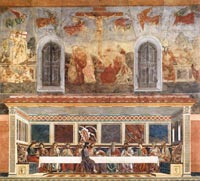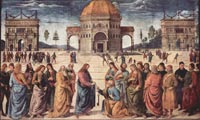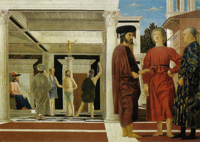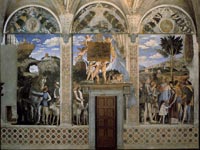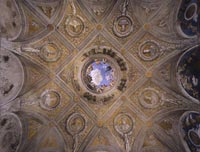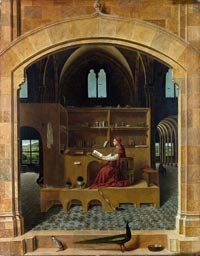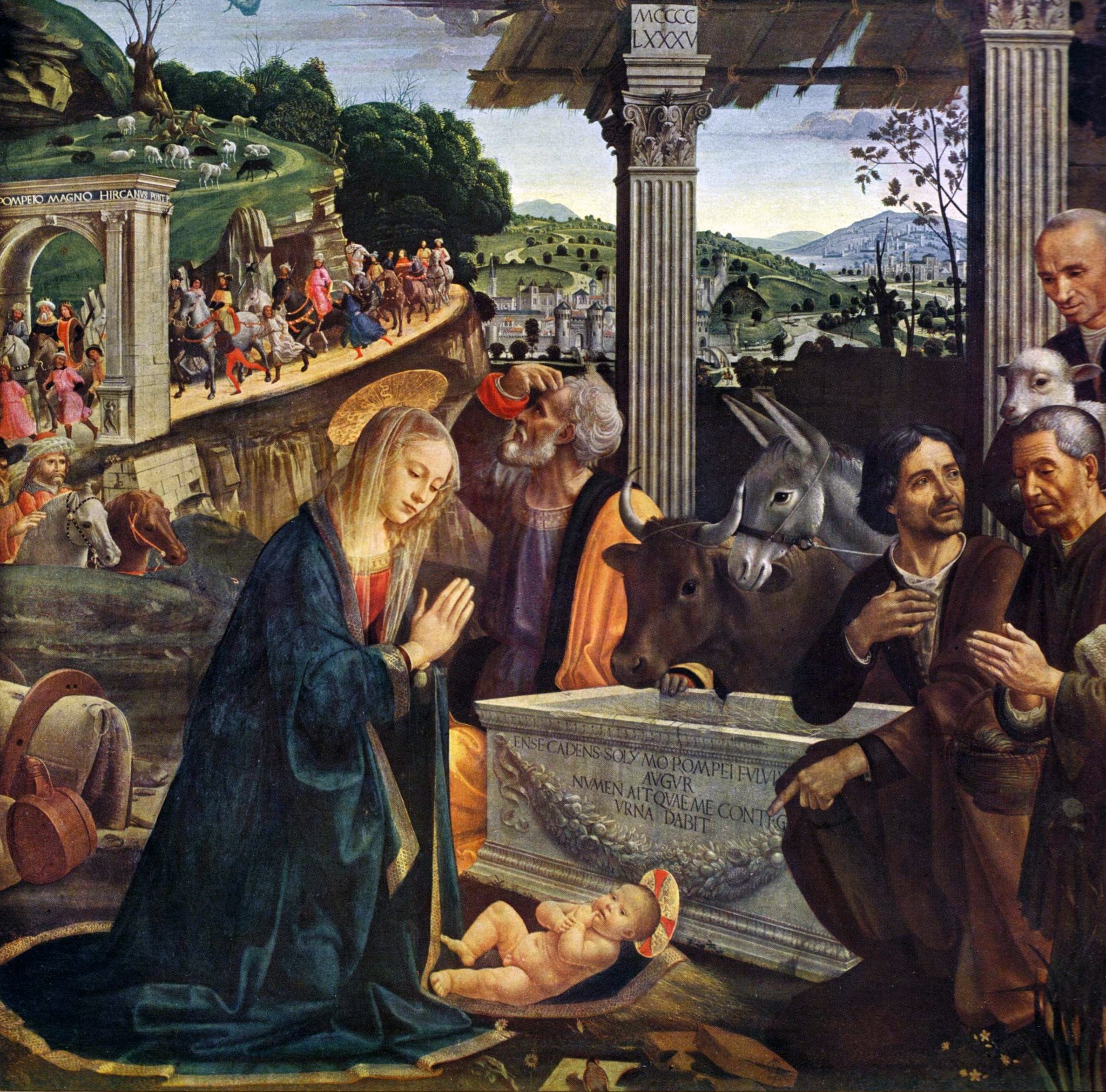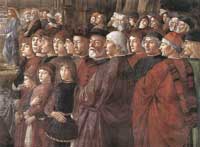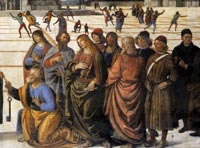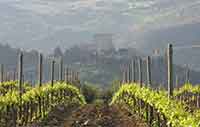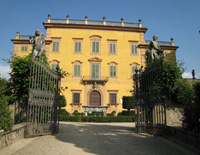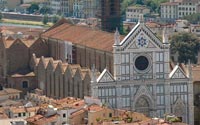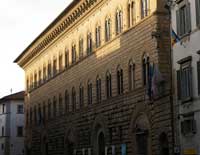Italian Renaissance painting |
| Italian Renaissance painting is the painting of the period beginning in the late 13th century and flourishing from the early 15th to late 16th centuries, occurring within the area of present-day Italy, which was at that time divided into many political areas. The painters of Renaissance Italy, although often attached to particular courts and with loyalties to particular towns, nonetheless wandered the length and breadth of Italy, often occupying a diplomatic status and disseminating both artistic and philosophical ideas.[0] |
Influences The influences upon the development of Renaissance painting in Italy are those that also affected Philosophy, Literature, Architecture, Theology, Science, Government and other aspects of society. The following is a summary of points dealt with more fully in the main articles that are cited above. Philiosophy Science and technology The establishment of the Medici Bank and the subsequent trade it generated brought unprecedented wealth to a single Italian city, Florence. Cosimo de' Medici set a new standard for patronage of the arts, not associated with the church or monarchy. The serendipitous presence within the region of Florence of certain individuals of artistic genius, most notably Giotto, Masaccio, Brunelleschi, Piero della Francesca, Leonardo da Vinci and Michelangelo, formed an ethos which supported and encouraged many lesser artists to achieve work of extraordinary quality.[2] A similar heritage of artistic achievement occurred in Venice through the talented Bellini family, their influential inlaw Mantegna, Giorgione, Titian and Tintoretto.[2][3][4] Themes |
||
Proto-Renaissance painting |
||
Traditions of 13th century Tuscan painting |
||
| The art of the region of Tuscany in the late 13th century was dominated by two masters of the Byzantine style, Cimabue of Florence and Duccio of Siena. Their commissions were mostly religious paintings, several of them being very large altarpieces showing the Madonna and Child. These two painters, with their contemporaries, Guido of Siena, Coppo di Marcovaldo and the mysterious painter upon whose style the school may have originated, the so-called Master of St. Bernardino, all worked in a manner that was highly formalised and dependent upon the ancient tradition of icon painting.[6] In these tempera paintings many of the details were rigidly fixed by the subject matter, the precise position of the hands of the Madonna and Christ Child, for example, being dictated by the nature of the blessing that the painting invoked upon the viewer. The angle of the Virgin's head and shoulders, the folds in her veil, and the lines with which her features were defined had all been repeated in countless such paintings. Cimabue's painting, while preserving many of the formal traits of the Byzantine style, is innovative in terms of the plastic strength. Cimabue and Duccio both took steps in the direction of greater naturalism, as did their contemporary, Pietro Cavallini of Rome.[2] |
||
Giotto |
||
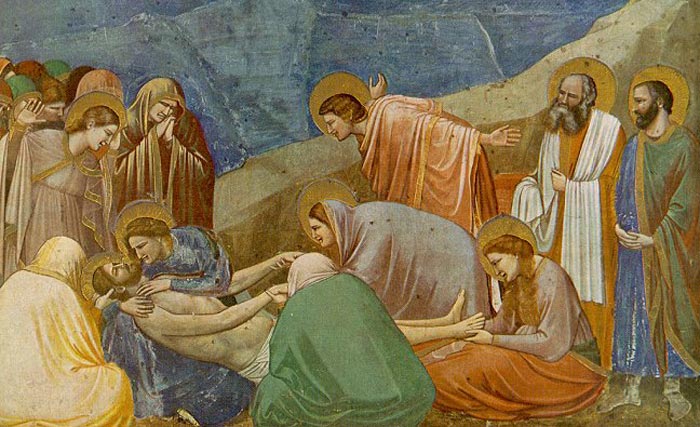 |
||
Giotto, Scenes from the Life of Christ, Lamentation (The Mourning of Christ), 1304-06, Cappella Scrovegni (Arena Chapel), Padua |
||
| Giotto, (1266–1337), by tradition a shepherd boy from the hills north of Florence, became Cimabue's apprentice and emerged as the most outstanding painter of his time.[7] Giotto, possibly influenced by Pietro Cavallini and other Roman painters, did not base the figures that he painted upon any painterly tradition, but upon the observation of life. Unlike those of his Byzantine contemporaries, Giotto's figures are solidly three-dimensional; they stand squarely on the ground, have discernible anatomy and are clothed in garments with weight and structure. But more than anything, what set Giotto's figures apart from those of his contemporaries are their emotions. In the faces of Giotto's figures are joy, rage, despair, shame, spite and love. The cycle of frescoes of the Life of Christ and the Life of the Virgin that he painted in the Scrovegni Chapel in Padua set a new standard for narrative pictures. His Ognissanti Madonna hangs in the Uffizi Gallery, Florence, in the same room as Cimabue's Santa Trinita Madonna and Duccio's Ruccellai Madonna where the stylistic comparisons between the three can easily be made.[8] One of the features apparent in Giotto's work is his observation of naturalistic perspective. He is regarded as the herald of the Renaissance.[9] The decoration of the Scrovegni Chapel in Padua (between 1303-1305) has been universally recognized as the most significant and most paradigmatic creation of Giotto and one of the capital events in the history of the European painting. If we look at the contents of his artistic revolution, we have to agree that the first manifestations are present in the decoration of the Assisi Upper Basilica. It is very probable that Giotto has worked in Assisi about ten years earlier than in Padua, that is to say, around 1290 or a little later. The concept of space formulated for the first time in Assisi was already known to the ancient Greeks and Romans, but had been lost in Medieval times. This is not just a new way of painting. The idea of an illusionary reconstruction of a three-dimensional space on a two-dimensional surface also implies that the reality perceived through one's senses acquires a new artistic meaning. Art in Tuscany | Giotto di Bondone |
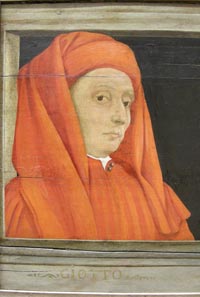 Paolo Uccello, detail of Five Masters of the Florentine Renaissance (or Fathers of Perspective), a portrait of Giotto), c. 1450, Tempera on wood, 43 x 210 cm, Musée du Louvre, Paris |
|
|
||
Giotto's contemporaries |
||
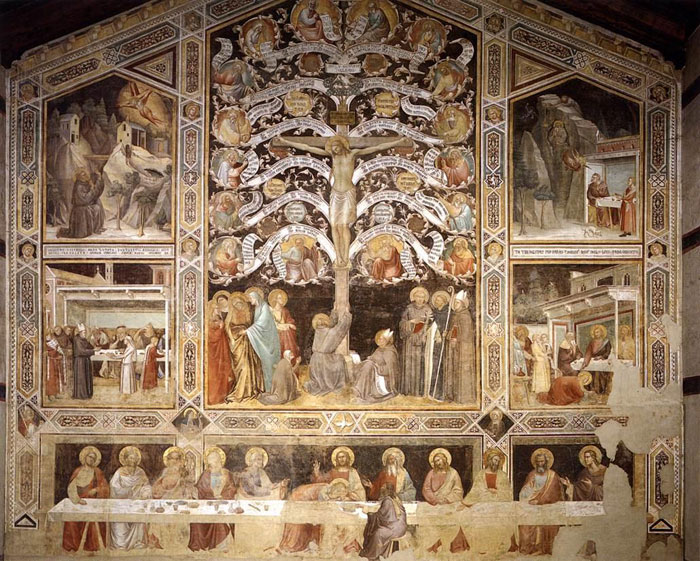 |
||
Taddeo Gaddi, Last Supper, Tree of Life and Four Miracle Scenes, 1360s, Fresco, 1120 x 1170 cm, Santa Croce, Florence
|
||
Giotto had a number of contemporaries who were either trained and influenced by him, or whose observation of nature had led them in a similar direction. Although several of Giotto's pupils assimilated the direction that his work had taken, none was to become as successful as he. Taddeo Gaddi achieved the first large painting of a night scene in an Annunciation to the Shepherds in the Baroncelli Chapel of the Church of Santa Croce, Florence.[2] |
||
Mortality and redemption |
||
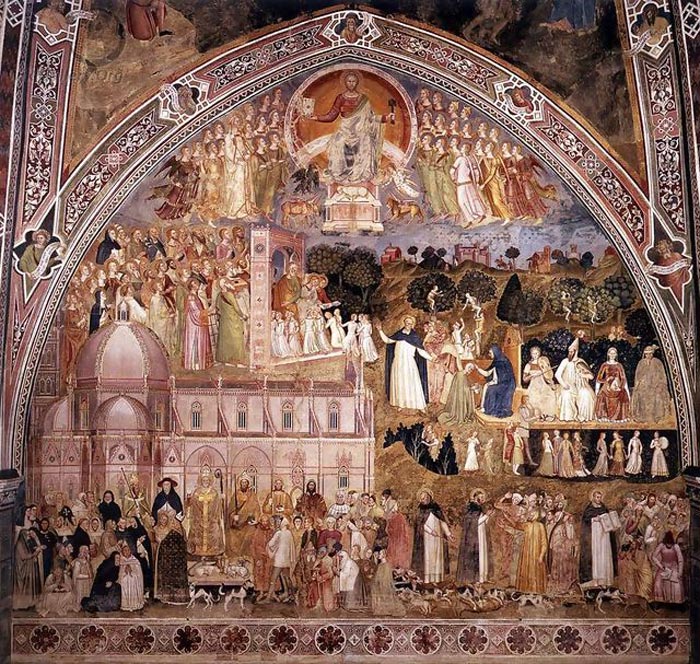 |
||
Andrea Bonaiuti, fresco in the The Spanish Chapel, Cappella Spagnuolo, Santa Maria Novella, Florence |
||
| A common theme in the decoration of Medieval churches was the Last Judgement, which frequently occupies a sculptural space above the west door, or, as in the case of the Giotto's Scrovegni Chapel, is painted on the inner west wall. The Black Death of 1348 caused its survivors to focus on the need to approach death in a state of penitence and absolution. The inevitability of death, the rewards for the penitent and the penalties of sin were emphasised in a number of frescoes, remarkable for their grim depictions of suffering and their surreal images of the torments of Hell. These include the Triumph of Death by Giotto's pupil Orcagna, now in a fragmentary state at the Museum of Santa Croce, and the Triumph of Death in the Camposanto Monumentale at Pisa by an unknown painter, perhaps Francesco Traini or Buonamico Buffalmacco who worked on the other three of a series of frescoes on the subject of Salvation. It is unknown exactly when these frescoes were begun but it is generally presumed they post-date 1348.[2] Two important fresco painters were active in Padua in the late 14th century, Altichiero and Giusto de' Menabuoi. Giusto's masterpiece, the decoration of the Cathedral's Baptistery, follows the theme of humanity's Creation, Downfall and Salvation, also having a rare Apocalypse cycle in the small chancel. While the whole work is exceptional for its breadth, quality and intact state, the treatment of human emotion is conservative by comparison with that of Altichiero's Crucifixion at the Basilica of Sant'Antonio, also in Padua. Giusto's work relies on formalised gestures, where Altichiero relates the incidents surrounding Christ's death with great human drama and intensity.[10] In Florence, at the Spanish Chapel of Santa Maria Novella, Andrea Bonaiuti was commissioned to emphasise the role of the Church in the redemptive process, and that of the Dominican Order in particular. His fresco Allegory of the Active and Triumphant Church is remarkable for its depiction of Florence Cathedral, complete with the dome which was not built until the following century.[2] |
||
|
||
International Gothic |
||
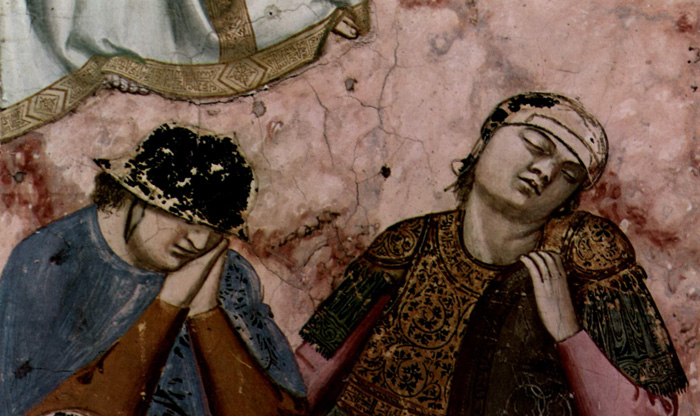 |
||
Giotto di Bondone, Scenes from the Life of Christ, Resurrection (detail), Cappella degli Scrovegni all'Arena, Padua |
||
| During the later 14th century, International Gothic was the style that dominated Tuscan painting. It can be seen to an extent in the work of Pietro and Ambrogio Lorenzetti which is marked by a formalized sweetness and grace in the figures, and Late Gothic gracefulness in the draperies. The style is fully developed in the works of Simone Martini and Gentile da Fabriano which have an elegance and a richness of detail, and an idealised quality not compatible with the starker realities of Giotto's paintings.[2] In the early 15th century, bridging the gap between International Gothic and the Renaissance are the paintings of Fra Angelico, many of which, being altarpieces in tempera, show the Gothic love of elaboration, gold leaf and brilliant colour. It is in his frescoes at his convent of Sant' Marco that Fra Angelico shows himself the artistic disciple of Giotto. These devotional paintings, which adorn the cells and corridors inhabited by the friars, represent episodes from the life of Jesus, many of them being scenes of the Crucifixion. They are starkly simple, restrained in colour and intense in mood as the artist sought to make spiritual revelations a visual reality.[2][11] Fra Angelico | Frescoes in the Convento di San Marco (1438-50) |
||
|
||
Early Renaissance painting |
||
| The earliest truly Renaissance images in Florence date from the first year of the century known in Italian as Quattrocento, synonymous with the Early Renaissance. At that date a competition was held to find an artist to create a pair of bronze doors for the Baptistry of St. John, the oldest remaining church in the city. The Baptistry is a large octagonal building in the Romanesque style, whose origins had been forgotten and which was popularly believed to date from Roman times. The interior of its dome is decorated with an enormous mosaic figure of Christ in Majesty thought to have been designed by Coppo di Marcovaldo. It has three large portals, the central one being filled at that time by a set of doors created by Andrea Pisano eighty years earlier. Pisano's doors were divided into 28 quatrofoil compartments, containing narratives scenes from the Life of John the Baptist. The competitors, of which there were seven young artists, were each to design a bronze panel of similar shape and size, representing the Sacrifice of Isaac. Two of the panels have survived, that by Lorenzo Ghiberti and that by Brunelleschi. Each panel shows some strongly classicising motifs indicating the direction that art and philosophy were moving, at that time. Ghiberti has used the naked figure of Isaac to create a small sculpture in the Classical style. He kneels on a tomb decorated with acanthus scrolls that are also a reference to the art of Ancient Rome. In Brunelleschi's panel, one of the additional figures included in the scene is reminiscent of a well-known Roman bronze figure of a boy pulling a thorn from his foot. Brunelleschi's creation is challenging in its dynamic intensity. Less elegant than Ghiberti's, it is more about human drama and impending tragedy.[12] Ghiberti won the competition. His first set of Baptistry doors took 27 years to complete, after which he was commissioned to make another. In the total of 50 years that Ghiberti worked on them, the doors provided a training ground for many of the artists of Florence. Being narrative in subject and employing not only skill in arranging figurative compositions but also the burgeoning skill of linear perspective, the doors were to have an enormous influence on the development of Florentine pictorial art. They were a unifying factor, a source of pride and camaraderie for both the city and its artists. Michelangelo was to call them the Gates of Paradise. |
||
|
||
The Brancacci Chapel |
||
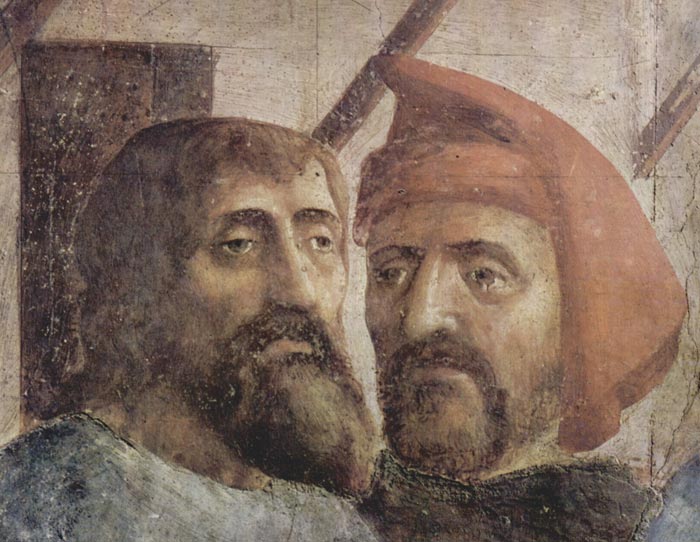 |
||
Masaccio, St Peter Healing the Sick with his Shadow, (detail) 1426-27, fresco, 230 x 162 cm, Cappella Brancacci, Santa Maria del Carmine, Florence
|
||
| In 1426 two artists commenced painting a fresco cycle of the Life of St. Peter in the chapel of the Brancacci family, at the Carmelite Church in Florence. They both were called by the name of Tommaso and were nicknamed Masaccio and Masolino, Big Tom and Little Tom. More than any other artist, Masaccio recognised the implications in the work of Giotto. He carried forward the practice of painting from nature. His paintings demonstrate an understanding of anatomy, of foreshortening, of linear perspective, of light and the study of drapery. Among his works, the figures of Adam and Eve being expelled from Eden, painted on the side of the arch into the chapel, are renowned for their realistic depiction of the human form and of human emotion. They contrast with the gentle and pretty figures painted by Masolino on the opposite side of Adam and Eve receiving the forbidden fruit. The painting of the Brancacci Chapel was left incomplete when Masaccio died at 26. The work was later finished by Filippino Lippi. Masaccio's work was to be a source of inspiration to many later painters, including both Leonardo da Vinci and Michelangelo.[13] Art in Tuscany | The Brancacci Chapel |
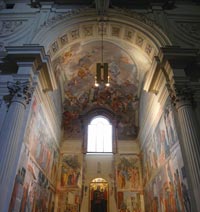 |
|
Andrea del Castagno |
||
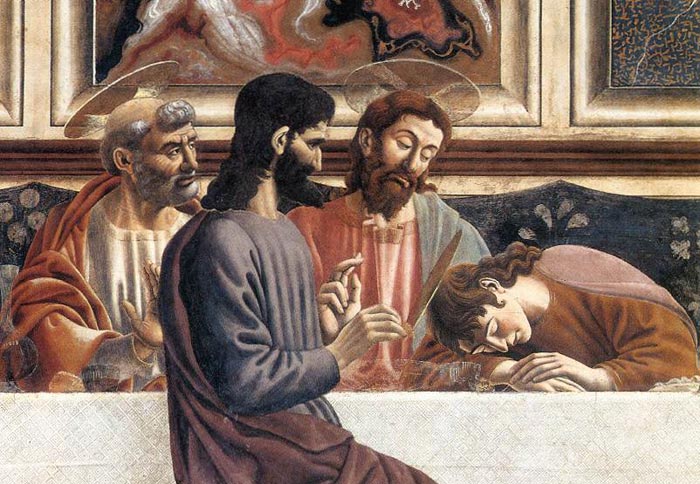 |
||
Andrea del Castagno, Last Supper (detail), 1447, fresco, Sant'Apollonia, Florence |
||
| Andrea del Castagno (originally Andrea di Bartolodi Bargilla), one of the most influential 15th-century Italian Renaissance painters, best known for the emotional power and naturalistic treatment of figures in his work. Little is known of Castagno's early life, and it is also difficult to ascertain the stages of his artistic development owing to the loss of many of his paintings. As a youth, he was precocious. He executed a mural of Cosimo de' Medici's adversaries (rebels hanging by their heels) at the Palazzo del Podestà in Florence, earning him the byname Andreino degli Impiccati ("Little Andrea of the Hanged Men"). His first notable works were a Last Supper and three scenes from the Passion of Christ, all for the former Convent of Sant'Apollonia in Florence, now known as the Cenacolo di Sant'Apollonia and also as the Castagno Museum. These monumental frescoes, revealing the influence of Masaccio's pictorial illusionism and Castagno's own use of scientific perspective, received wide acclaim. In his altarpiece painting of the Assumption of the Virgin for San Miniato fra le Torri in Florence, Castagno's style more closely resembled International Gothic. Art in Tuscany | Andrea del Castagno, Last Supper, 1447 |
||
|
||
The development of linear perspective |
||
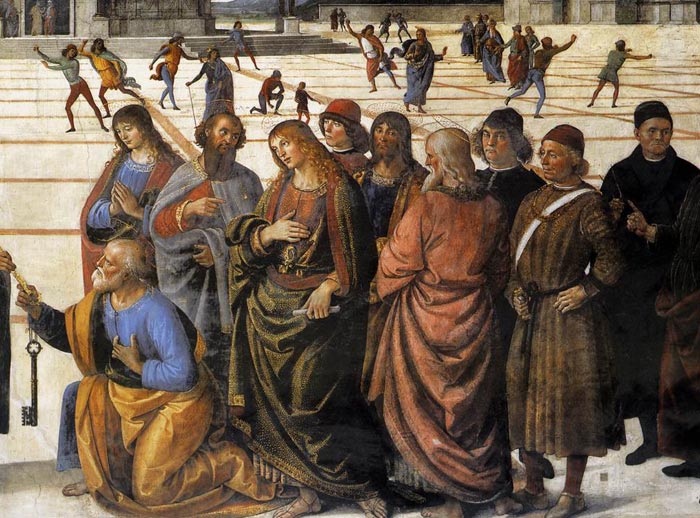 |
||
Il Perugino, Christ Handing the Keys to St Peter, Cappella Sistina, Vatican, Rome
|
||
| During the first half of the 15th century, the achieving of the effect of realistic space in a painting by the employment of linear perspective was a major preoccupation of many painters, as well as the architects Brunelleschi and Alberti who both theorised about the subject. Brunelleschi is known to have done a number of careful studies of the piazza and octagonal baptistery outside Florence Cathedral and it is thought he aided Masaccio in the creation of his famous trompe l'oeil niche around the Holy Trinity he painted at Santa Maria Novella.[13] According to Vasari, Paolo Uccello was so obsessed with perspective that he thought of little else and experimented with it in many paintings, the best known being the three Battle of San Romano pictures which use broken weapons on the ground, and fields on the distant hills to give an impression of perspective. In the 1450s Piero della Francesca, in paintings such as The Flagellation of Christ, demonstrated his mastery over linear perspective and also over the science of light. Another painting exists, a cityscape, by an unknown artist, perhaps Piero della Francesca, that demonstrates the sort of experiment that Brunelleschi had been making. From this time linear perspective was understood and regularly employed, notably by Perugino in his Christ Giving the Keys to St. Peter in the Sistine Chapel.[12] |
||
|
||
The understanding of light |
||
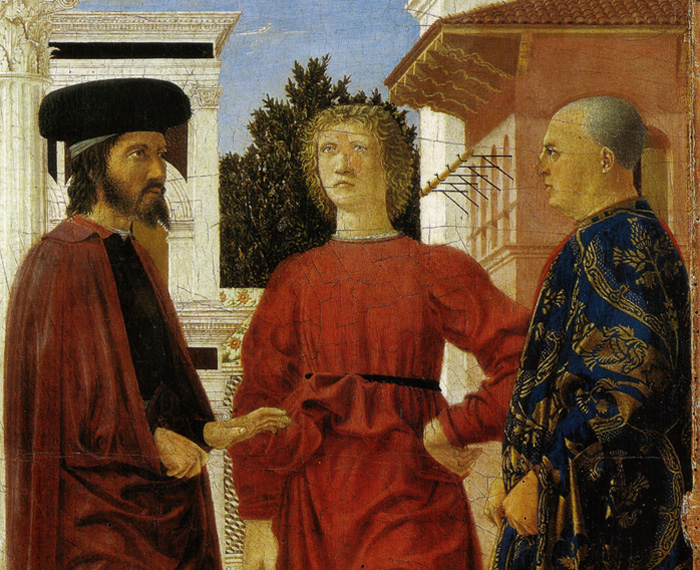 |
||
Piero della Francesca, The Flagellation (detail), c. 1455, Oil and tempera on panel, 59 x 82 cm, Galleria Nazionale delle Marche, Urbino |
||
| Giotto used tonality to create form. Taddeo Gaddi in his nocturnal scene in the Baroncelli Chapel demonstrated how light could be used to create drama. Paolo Uccello, a hundred years later, experimented with the dramatic effect of light in some of his almost-monochrome frescoes. He did a number of these in terra verde or "green earth", enlivening his compositions with touches of vermilion. The best known is his equestrian portrait of John Hawkwood on the wall of Florence Cathedral. Both here and on the four heads of prophets that he painted around the inner clockface in the cathedral, he used strongly contrasting tones, suggesting that each figure was being lit by a natural light source, as if the source was an actual window in the cathedral.[14] Piero della Francesca carried his study of light further. In the Flagellation he demonstrates a knowledge of how light is proportionally disseminated from its point of origin. There are two sources of light in this painting, one internal to a building and the other external. Of the internal source, though the light itself is invisible, its position can be calculated with mathematical certainty. Leonardo da Vinci was to carry forward Piero's work on light.[15] |
||
The Madonna |
||
| The Blessed Virgin Mary, revered by the Catholic Church worldwide, was particularly evoked in Florence, where there was a miraculous image of her on a column in the corn market and where both the Cathedral of "Our Lady of the Flowers" and the large Dominican church of Santa Maria Novella were named in her honour. The miraculous image in the corn market was sadly destroyed by fire, but replaced with a new image in the 1330s by Bernardo Daddi, set in an elaborately designed and lavishly wrought canopy by Orcagna. The open lower storey of the building was enclosed and dedicated as Orsanmichele. Depictions of the Madonna and Child were a very popular art form in Florence. They took every shape from small mass-produced terracotta plaques to magnificent altarpieces such as those by Cimabue, Giotto and Masaccio. In the 15th and first half of the 16th centuries, one workshop more than any other dominated the production of Madonnas. They were the della Robbia family, and they were not painters but modellers in clay. Luca della Robbia, famous for his cantoria gallery at the cathedral, was the first sculptor to use glazed terracotta for large sculptures. Many of the durable works of this family have survived. The skill of the della Robbias, particularly Andrea della Robbia, was to give great naturalism to the babies that they modelled as Jesus, and expressions of great piety and sweetness to the Madonna. They were to set a standard to be emulated by other artists of Florence. Among those who painted devotional Madonnas during the Early Renaissance are Fra Angelico, Fra Filippo Lippi, Verrocchio and Davide Ghirlandaio. The custom was continued by Botticelli who produced a series of Madonnas over a period of twenty years for the Medici; Perugino, whose Madonnas and saints are known for their sweetness and Leonardo da Vinci, for whom a number of small attributed Madonnas such as the Benois Madonna have survived. Even Michelangelo who was primarily a sculptor, was persuaded to paint the Doni Tondo, while for Raphael, they are among his most popular and numerous works. |
||
|
||
Early Renaissance painting in other parts of Italy Andrea Mantegna in Mantua |
||
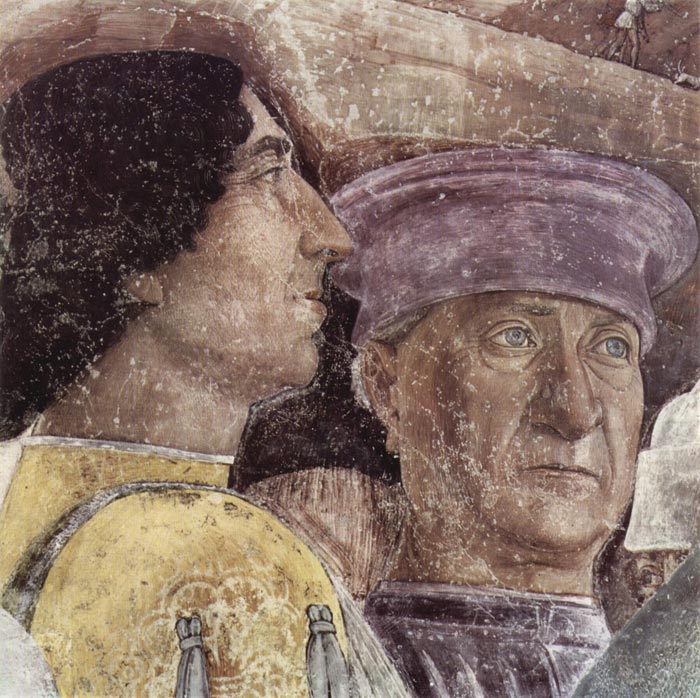 |
||
Mantegna's frescos in Palazzo Ducale in Mantua, Ludovico Gonzaga greeting cardinal Francesco Gonzaga, (detail, possibly self-portrait Mantegna and Leon Battista Alberti) |
||
| One of the most influential painters of northern Italy was Andrea Mantegna of Padua, who had the good fortune to be in his teen years at the time in which the great Florentine sculptor Donatello was working there. Donatello created the enormous equestrian bronze, the first since the Roman Empire, of the condotiero Gattemelata, still visible on its plinth in the square outside the Basilica of Sant'Antonio. He also worked on the high altar and created a series of bronze panels in which he achieved a remarkable illusion of depth, with perspective in the architectural settings and apparent roundness of the human form all in very shallow relief. At only 17 years old, Mantegna accepted his first commission, fresco cycles of the Lives of Saints James and Christopher for the Eremitani Chapel, near the Scrovegni Chapel in Padua. Unfortunately the building was mostly destroyed during World War II, and they are only known from photographs which reveal an already highly developed sense of perspective and a knowledge of antiquity, for which the ancient University of Padua had become well known, early in the 15th century.[16] Mantegna's most famous work is the interior decoration of the Camera degli Sposi for the Gonzaga family in Mantua, dated about 1470. The walls are frescoed with scenes of the life of the Gonzaga family, talking, greeting a younger son and his tutor on their return from Rome, preparing for a hunt and other such scenes which make no obvious reference to matters historic, literary, philosophic or religious. They are remarkable for simply being about family life. The one concession is the scattering of jolly winged cherubs who hold up plaques and garlands and clamber on the illusionistic pierced balustrade that surrounds a trompe l'oeil view of the sky that decks the ceiling of the chamber.[12] One the most remarkable portions of the decoration of the Camera degli Sposi is the fictive oculus, or opening to the sky, located on the room's low ceiling. Created with sharp foreshortenings, the oculus is ringed with figures looking down on the room below; a potted plant is precariously perched on its wooden support, seemingly ready to fall at any moment. It is a brilliant tour de force that invariably engages the spectator, who must join in the game by standing directly beneath the circular trellis. |
||
|
||
Cosmè Tura in Ferrara |
||
| While Mantegna was working for the Gonzagas in Mantua, a very different painter was being employed to design an even more ambitious scheme for the Este family of Ferrara. Cosmè Tura's painting is highly distinctive, both strangely Gothic yet Classicising at the same time. Tura poses Classical figures as if they were saints, surrounds them with luminous symbolic motifs of surreal perfection and clothes them in garments that appear to be crafted out of intricately folded and enamelled copper.[12] Borso d'Este's family had constructed a large banquetting hall and suite known as the Palazzo Schifanoia.[17] Borso, according to Tura's personal records, employed him in 1470 to design the decorative scheme for the banquetting hall, to be executed by Francesco del Cossa and Ercole de' Roberti. The scheme is both symbolically complex and elaborate in execution. The overriding theme is the Cycle of the Year as represented by the signs of the zodiac accompanied by the mysterious Deans each ruling ten days of the month. Above them, seated in a spectacular array of chariots drawn by lions, eagles, unicorns and other such beasts, are twelve Roman deities with their various attributes. In the lower tiers, as in the Camera degli Sposi, are shown the life of the family. For the month of March, for example, the figure of Minerva, Goddess of Wisdom, is represented and in the panel beneath Borso d'Este is administering justice, while in the distance workers are pruning vines. Although areas of the frescoes are very badly damaged to the extent that the subject can no longer be identified, and although there are several different hands apparent in the works, there appears to be a consistency in the design of every remaining scene that shows the overriding eccentric style of Cosmè Tura.[18] |
||
|
||
Antonello da Messina |
||
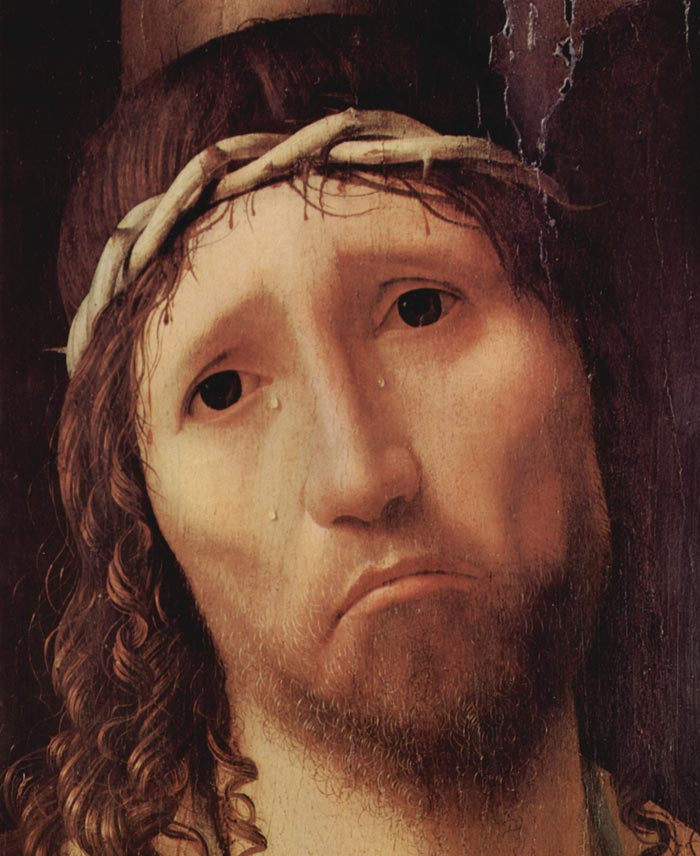 |
||
Antonello da Messina, Ecce Homo (detail), 1473, Collegio Alberoni, Piacenza |
||
| In 1442 Alfonso V of Aragon became ruler of Naples, bringing with him a collection of Flemish paintings and setting up a Humanist Academy. The painter Antonello da Messina seems to have had access to the King's collection, which may have included the works of Jan van Eyck.[19] He seems to have been exposed to Flemish painting at a date earlier than the Florentines, to have quickly seen the potential of oils as a medium and then painted in nothing else. He carried the technique north to Venice with him, where it was soon adopted by Giovanni Bellini and became the favoured medium of the maritime republic where the art of fresco had never been a great success.
Antonello da Messina painted mostly small meticulous portraits in glowing colours. But one of his most famous works also demonstrates his superior ability at handling linear perspective and light. This is the small painting of St. Jerome in His Study, in which the composition is framed by a late Gothic arch, through which is viewed an interior, domestic on one side and ecclesiastic on the other, in the centre of which the saint sits in a wooden corral surrounded by his possessions while his lion prowls in the shadows on the tiled floor. The way that the light streams in through every door and window casting both natural light and reflected light across the architecture and all the objects would have excited Piero della Francesca. Antonello's work influenced both Gentile Bellini, who did a series of paintings of Miracles of Venice for the Scuola di Santa Croce, and his more famous brother, Giovanni, one of the most significant painters of the High Renaissance in Northern Italy.[2][16] |
||
Patronage and Humanism |
||
Sandro Botticelli, Primavera, c. 1486, Uffizi Gallery, Firenze
|
||
In Florence, in the later 15th century, most works of art, even those that were done as decoration for churches, were generally commissioned and paid for by private patrons. Much of the patronage came from the Medici family, or those who were closely associated with or related to them, such as the Sassetti, the Ruccellai and the Tornabuoni.
|
||
![Domenico Ghirlandaio: Zachariah in the Temple [detail]: four humanist philosophers under the patronage of the Medici:](/images/art/ghirlandaio/zachariah1700.jpg) |
||
Domenico Ghirlandaio: Zachariah in the Temple [detail]: four humanist philosophers under the patronage of the Medici: Marsilio Ficino, Cristoforo Landino, Angelo Poliziano and Demetrios Chalkondyles, 1486-1490, fresco in the Cappella Tornabuoni, Santa Maria Novella, Florence
|
||
Flemish influence |
||
 |
||
Hugo Van der Goes, The Adoration of the Shepherds, 1476-79, oil on wood, 253 x 304 cm, Galleria degli Uffizi, Firenze
|
||
| From about 1450, with the arrival in Italy of the Flemish painter Rogier van der Weyden and possibly earlier, artists were introduced to the medium of oil paint. Whereas both tempera and fresco lent themselves to the depiction of pattern, neither presented a successful way to represent natural textures realistically. The highly flexibly medium of oils, which could be made opaque or transparent, and allowed alteration and additions for days after it had been laid down, opened a new world of possibility to Italian artists.
In 1475 a huge altarpiece of the Adoration of the Shepherds arrived in Florence. Painted by Hugo van der Goes at the behest of the Portinari family, it was shipped out from Bruges for the Chapel of Sant' Egidio at the hospital of Santa Maria Nuova. The altarpiece glows with intense reds and greens, contrasting with the glossy black velvet robes of the Portinari donors. In the foreground is a still life of flowers in contrasting containers, one of glazed pottery and the other of glass. The glass vase alone was enough to excite attention. But the most influential aspect of the triptych was the extremely natural and lifelike quality of the three shepherds with stubbly beards, workworn hands and expressions ranging from adoration to wonder to incomprehension. Domenico Ghirlandaio promptly painted his own version, with a beautiful Italian Madonna in place of the long-faced Flemish one, and himself, gesturing theatrically, as one of the shepherds.[12] |
||
The Papal commission |
||
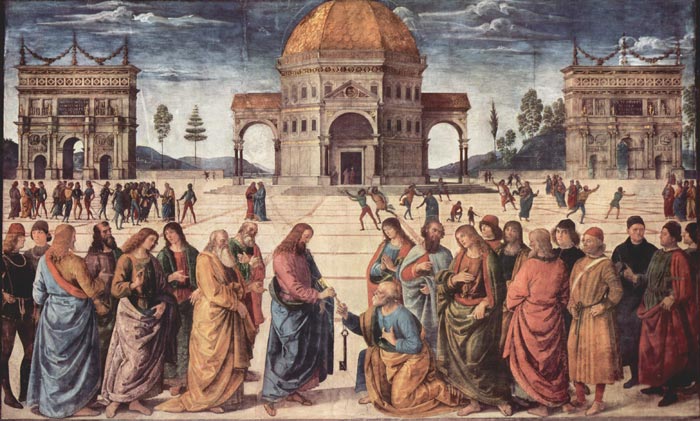 |
||
Il Perugino, Christ Handing the Keys to St Peter, Cappella Sistina, Vatican, Rome |
||
| In 1477 Pope Sixtus IV replaced the derelict old chapel at the Vatican in which many of the Papal services were held. The interior of the new chapel, named the Sistine Chapel in his honour, appears to have been planned from the start to have a series of 16 large frescoes between its pilasters on the middle level, with a series of painted portraits of popes above them. In 1479, a group of artists from Florence was commissioned with the work: Botticelli, Perugino, Ghirlandaio and Cosimo Rosselli. This fresco cycle was to depict the Life of Moses on one side of the chapel and the Life of Christ on the other with the frescoes complementing each other in theme. The Nativity of Jesus and the Finding of Moses were adjacent on the wall behind the altar, with an altarpiece of the Assumption of the Virgin by Perugino between them. The four paintings on the end walls were unfortunately destroyed. The remaining 12 pictures indicate the virtuosity that these artists had attained, and the obvious cooperation between individuals who normally employed very different styles and who had very different skills. The paintings gave full range to their capabilities as they included a great number of figures of men, women and children and characters ranging from guiding angels to enraged Pharaohs and the devil himself. Each painting required a landscape. Because of the scale of the figures that the artists agreed upon, in each picture, the landscape and sky take up the whole upper half of the scene. Sometimes, as in Botticelli's scene of the Purification of the Leper, there are additional small narratives taking place in the landscape, in this case the Temptation of Christ. Of the paintings, one stands out. It is Perugino's scene of Christ giving the Keys to St. Peter. This picture is remarkable for the clarity and simplicity of its composition, the beauty of the figurative painting, which includes a selfportrait among the onlookers, and especially the perspective cityscape which includes reference to Peter's ministry to Rome by the presence of two triumphal arches, and centrally placed an octagonal building which might be a Christian baptistry or a Roman Mausoleum.[22] |
||
Leonardo da Vinci |
||
Leonardo, because of the scope of his interests and the extraordinary degree of talent that he demonstrated in so many diverse areas, is regarded as the archetypal "Renaissance man". But it was first and foremost as a painter that he was admired within his own time, and as a painter, he drew on the knowledge that he gained from all his other interests. Leonardo was a scientific observer. He learned by looking at things. He studied and drew the flowers of the fields, the eddies of the river, the form of the rocks and mountains, the way light reflected from foliage and sparkled in a jewel. In particular, he studied the human form, dissecting thirty or more unclaimed cadavers from a hospital in order to understand muscles and sinews. More than any other artist, he advanced the study of "atmosphere". In his paintings such as the Mona Lisa and Virgin of the Rocks, he used light and shade with such subtlety that, for want of a better word, it became known as Leonardo's "sfumato" or "smoke". Simultaneous to inviting the viewer into a mysterious world of shifting shadows, chaotic mountains and whirling torrents, Leonardo achieved a degree of realism in the expression of human emotion, prefigured by Giotto but unknown since Masaccio's Adam and Eve. Leonardo's Last Supper, painted in the refectory of a monastery in Milan, became the benchmark for religious narrative painting for the next half millennium. Many other Renaissance artists painted versions of the Last Supper, but only Leonardo's was destined to be reproduced countless times in wood, alabaster, plaster, lithograph, tapestry, crochet and table-carpets. Apart from the direct impact of the works themselves, Leonardo's studies of light, anatomy, landscape, and human expression were disseminated in part through his generosity to a retinue of students[7]. |
||
Michelangelo |
||
In 1508 Pope Julius II succeeded in getting the sculptor Michelangelo to agree to continue the decorative scheme of the Sistine Chapel. The Sistine Chapel ceiling was constructed in such a way that there were twelve sloping pendentives supporting the vault that formed ideal surfaces on which to paint the Twelve Apostles. Michelangelo, who had yielded to the Pope's demands with little grace, soon devised an entirely different scheme, far more complex both in design and in iconography. The scale of the work, which he executed single handed except for manual assistance, was titanic and took nearly five years to complete. The Pope's plan for the Apostles would thematically have formed a pictorial link between the Old Testament and New Testament narratives on the walls, and the popes in the gallery of portraits.[22] It is the twelve apostles, and their leader Peter as first Bishop of Rome, that make that bridge. But Michelangelo's scheme went the opposite direction. The theme of Michelangelo's ceiling is not God's grand plan for humanity's salvation. The theme is about humanity's disgrace. It is about why humanity needed, and in the terms of the faith, needs Jesus.[23] Superficially, the ceiling is a Humanist construction. The figures are of superhuman dimension and, in the case of Adam, of such beauty that according to the biographer Vasari, it really looks as if God himself had designed the figure, rather than Michelangelo. But despite the beauty of the individual figures, Michelangelo has not glorified the human state, and he certainly has not presented the Humanist ideal of platonic love. In fact, the ancestors of Christ, which he painted around the upper section of the wall, demonstrate all the worst aspects of family relationships, displaying disfunction in as many different forms as there are families.[23] Vasari praised Michelangelo's seemingly infinite powers of invention in creating postures for the figures. Raphael, who was given a preview by Bramante after Michelangelo had downed his brush and stormed off to Bologna in a temper, painted at least two figures in imitation of Michelangelo's prophets, one at the church of Sant' Agostino and the other in the Vatican, his portrait of Michelangelo himself in The School of Athens.[22][24][25] |
||
Raphael |
||
| With Leonardo da Vinci and Michelangelo, Raphael's name is synonymous with the High Renaissance. However, he was younger than Michelangelo by 18 years and Leonardo by nearly 30. It cannot be said of him that he greatly advanced the state of painting as his two famous contemporaries did. Rather, his work was the culmination of all the developments of the High Renaissance. Raphael had the good luck to be born the son of a painter, so his career path, unlike that of Michelangelo who was the son of minor nobility, was decided without a quarrel. Some years after his father's death he worked in the Umbrian workshop of Perugino, an excellent painter and a superb technician. His first signed and dated painting, executed at the age of 21, is the Betrothal of the Virgin, which immediately reveals its origins in Perugino's Christ giving the Keys to Peter.[16] Raphael was a carefree character who unashamedly drew on the skills of the renowned painters whose lifespans encompassed his. In his works the individual qualities of numerous different painters are drawn together. The rounded forms and luminous colours of Perugino, the lifelike portraiture of Ghirlandaio, the realism and lighting of Leonardo and the powerful draughtsmanship of Michelangelo became unified in the paintings of Raphael. In his short life he executed a number of large altarpieces, an impressive Classical fresco of the sea nymph, Galatea, outstanding portraits with two popes and a famous writer among them, and, while Michelangelo was painting the Sistine Chapel ceiling, a series of wall frescoes in the Vatican chambers nearby, of which the School of Athens is uniquely significant. This fresco depicts a meeting of all the most learned ancient Athenians, gathered in a grand classical setting around the central figure of Plato, whom Raphael has famously modelled upon Leonardo da Vinci. The brooding figure of Heraclitus who sits by a large block of stone, is a portrait of Michelangelo, and is a reference to the latter's painting of the Prophet Jeremiah in the Sistine Chapel. His own portrait is to the right, beside his teacher, Perugino.[26] But the main source of Raphael's popularity was not his major works, but his small Florentine pictures of the Madonna and Christ Child. Over and over he painted the same plump calm-faced blonde woman and her succession of chubby babies, the most famous probably being La Belle Jardinière ("The Madonna of the Beautiful Garden"), now in the Louvre. His larger work, the Sistine Madonna, used as a design for countless stained glass windows, has come, in the 21st century, to provide the iconic image of two small cherubs which has been reproduced on everything from paper table napkins to umbrellas.[27][28] |
||
Giovanni Bellini |
||
| Giovanni Bellini was the exact contemporary of his brother Gentile, his brother-in-law Mantegna and Antonello da Messina. Working most of his life in the studio of his brother, and strongly influenced by the crisp style of Mantegna, he does not appear to have produced an independently signed painting until he was in his late 50s. During the last 30 years of his life he was both extraordinarily productive and influential, having the guidance of both Giorgione and Titian. Bellini, like his much younger contemporary, Raphael, produced numerous small Madonnas in rich glowing colour, usually of more intense tonality than his Florentine counterpart. These Madonnas multiplied prolifically as they were reproduced by other members of the large Bellini studio, one tiny picture, the Circumcision of Christ existing in four or five almost identical versions.
Traditionally, in the painting of altarpieces of the Madonna and Child, the enthroned figure of the Virgin is accompanied by saints, who stand in defined spaces, separated physically in the form of a polytych or defined by painted architectural boundaries. Piero della Francesca used the Classical niche as a setting for his enthroned Madonnas, as Masaccio had used it as the setting for his Holy Trinity at Santa Maria Novella. Piero grouped saints around the throne, in the architectural space.Bellini used this same form, known as Sacred conversations, in several of his later altarpieces such as that for the Venetian church of San Zaccaria. It is a masterful composition which extends the real architecture of the building into the illusionistic architecture of the painting, making the niche a sort of loggia opened up to the landscape and to daylight which streams across the figures of the Virgin and Child, the two female saints and the little angel who plays a viola making them brighter than the two elderly male saints who stand to the fore in the picture, Peter deep in thought and Jerome immersed in a book.[29] |
||
|
||
| Whilst the style of Giorgione's painting clearly relates to that of his presumed master, Giovanni Bellini, his subject matter makes him one of the most original and abstruse artists of the Renaissance. One of his paintings, of a landscape known as the Tempest, with a semi-naked woman feeding a baby, a clothed man, some classical columns and a flash of lightning, perhaps represents Adam and Eve in their post-Eden days, or perhaps it doesn't. Another painting, called the Philosophers may represent the Magi planning their journey in search of the infant Christ, but this is not certain either. One thing that appears to be certain is that Giorgione painted a female nude, the very first female nude that stands, or rather, lies, as a subject to be portrayed and admired for beauty alone. There are no need for Classical references in this painting, although in later nudes Titian, Velazquez, Veronese, Rembrandt, Rubens and even Manet saw fit to add some. They are the artistic heirs of Giorgione's nude. On his premature death, Titian completed the painting and went on to paint a great more naked women, most frequently, as Botticelli did, disguising them as goddesses and surrounding them with sylvan woods and starry skies to make perfect decoration for the walls of rich clientele. But it was as a painter of portraits that Titian excelled, his longevity allowing him to achieve far more, both in the way of production and in stylistic development than either Giorgione or his Florentine contemporary Raphael were able to. Titian gave the world images of Pietro Aretino and Pope Paul III and many other people of his day, perhaps his most powerful portrait being that of Doge Andrea Gritti, ruler of Venice, who looms large in the picture space, one huge hand clasping his heavily-buttoned robe in a dynamic Expressionistic gesture. Titian is also renowned for his religious painting, his last work being a turbulent and abstracted Pieta.[12][30] |
||
|
||
| Michelangelo and Titian both lived into the second half of the 16th century. Both saw their styles and those of Leonardo, Mantegna, Giovanni Bellini, Antonello da Messina and Raphael adapted by later painters to form a disparate style known as Mannerism, and move steadily towards the great outpouring of imagination and painterly virtuosity of the Baroque period.
The artist who most extended the trends in Titian's large figurative compositions is Tintoretto, although his personal manner was such that he only lasted nine days as Titian's apprentice. Rembrandt's knowledge of the works of both Titian and Raphael is apparent in his portraits. The direct influences of Leonardo and Raphael upon their own pupils was to effect generations of artists including Poussin and schools of Classical painters of the 18th and 19th centuries. Antonello da Messina's work had a direct influence on Albrecht Dürer and Martin Schongauer and through the latter's engravings, countless artists including the German, Dutch and English schools of stained glass makers extending into the early 20th century.[16] Michelangelo's Sistine Chapel ceiling and later The Last Judgment had direct influence on the figurative compositions firstly of Raphael and his pupils and then almost every subsequent 16th century painter who looked for new and interesting ways to depict the human form. It is possible to trace his style of figurative composition through Andrea del Sarto, Pontormo, Bronzino, Parmigianino, Veronese, to el Greco, Carracci, Caravaggio, Rubens, Poussin and Tiepolo to both the Classical and the Romantic painters of the 19th century such as Jacques Louis David and Delacroix. Under the influence of the Italian Renaissance painting, many modern academies of art, such as the Royal Academy, were founded, and it was specifically to collect the works of the Italian Renaissance that some of the world's best known art collections, such as the National Gallery, London, were formed. |
||
|
||
|
||
|
||
|
||
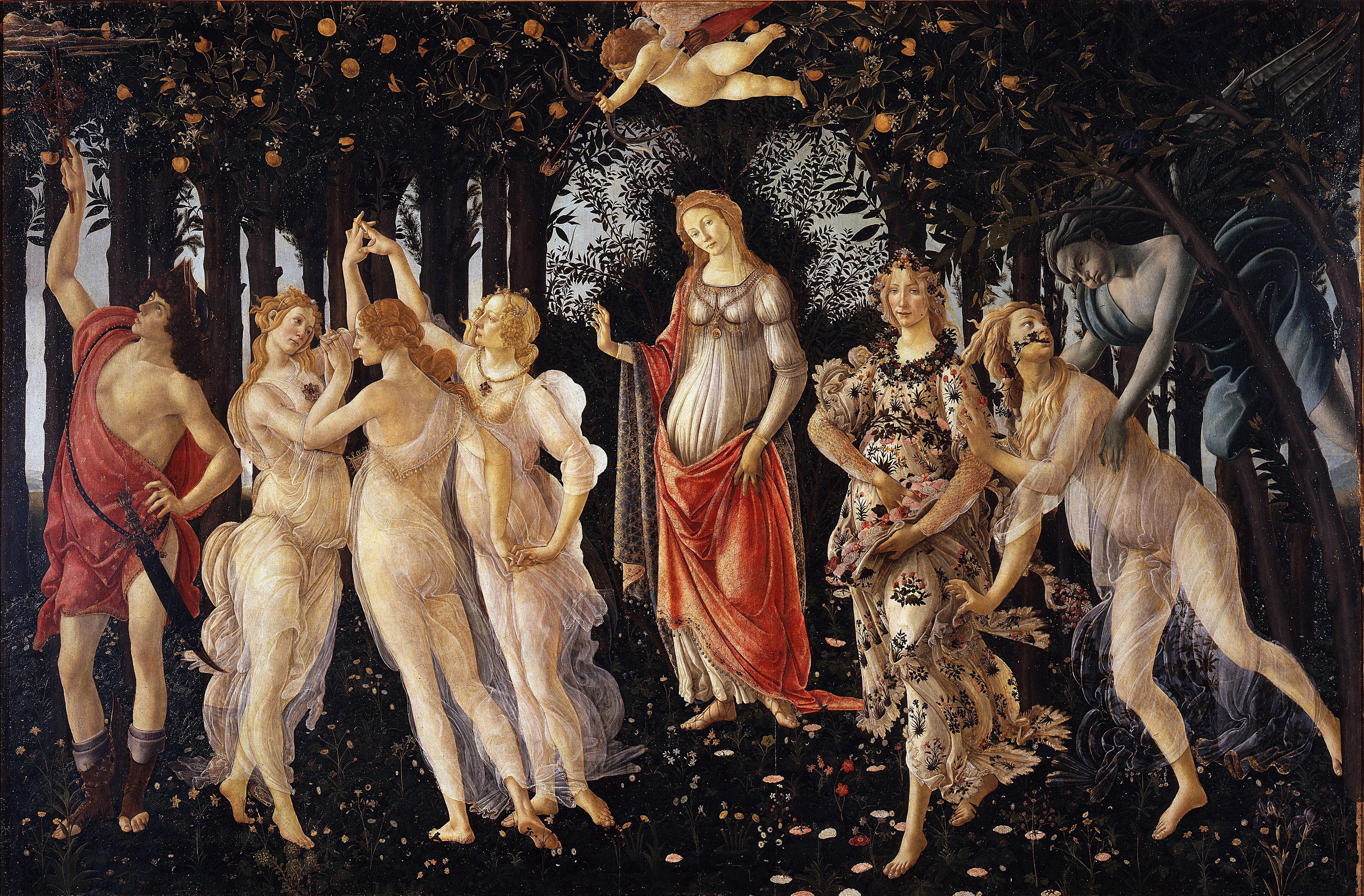
[0] Victoria Charles, Renaissance Art, Parkstone Press International, New York, USA [1] eg. Antonello da Messina who travelled from Sicily to Venice via Naples. [2] a b c d e f g h i j Frederick Hartt, A History of Italian Renaissance Art, (1970) [3] a b Michael Baxandall, Painting and Experience in Fifteenth Century Italy, (1974) [4] Margaret Aston, The Fifteenth Century, the Prospect of Europe, (1979) [5] Keith Christiansen, Italian Painting, (1992) [6] John White, Duccio, (1979) [7] Giorgio Vasari, Lives of the Artists, (1568) [8] All three are reproduced and compared at Italian Renaissance painting, development of themes [9] Sarel Eimerl, The World of Giotto, (1967) [10] Mgr. Giovanni Foffani, Frescoes by Giusto de' Menabuoi, (1988) [11] Helen Gardner, Art through the Ages, (1970) [12] R.E. Wolf and R. Millen, Renaissance and Mannerist Art, (1968) [13] Ornella Casazza, Masaccio and the Brancacci Chapel, (1990) [14] Annarita Paolieri, Paolo Uccello, Domenico Veneziano, Andrea del Castagno, (1991) [15] Peter Murray and Pier Luigi Vecchi, Piero della Francesca, (1967) [16] Diana Davies, Harrap's Illustrated Dictionary of Art and Artists, (1990) [17] Schifanoia means "disgust of annoyances", or "Sans Souci", and indeed it lacks anything so commonplace as a kitchen so that all the food had to be transported. [18] Ranieri Varese, Il Palazzo di Schifanoia, (1980) [19] Ilan Rachum, The Renaissance, an Illustrated Encyclopedia, (1979) [20] Hugh Ross Williamson, Lorenzo the Magnificent, (1974) [21] Umberto Baldini, Primavera, (1984) [22] Massimo Giacometti, The Sistine Chapel, (1986) [23] T.L.Taylor, The Vision of Michelangelo, Sydney University, (1982) [24] Gabriel Bartz and Eberhard König, Michelangelo, (1998) [25] Ludwig Goldschieder, Michelangelo, (1962) [26] Some sources identify this figure as Sodoma, but it is an older, grey-haired man, while Sodoma was in his 30s. Moreover, it strongly resembles several self-portraits of Perugino, who would have been about 60 at the time. [27] David Thompson, Raphael, the Life and Legacy, (1983) [28] Jean-Pierre Cuzin, Raphael, his Life and Works, (1985) [29] Mariolina Olivari, Giovanni Bellini, (1990) [30] Cecil Gould, Titian, (1969) |
||||
| Bibliography General Giorgio Vasari, Lives of the Artists, (1568), 1965 edition, trans George Bull, Penguin, ISBN 0140441646 Frederick Hartt, A History of Italian Renaissance Art, (1970) Thames and Hudson, ISBN 0500231362 R.E. Wolf and R. Millen, Renaissance and Mannerist Art, (1968) Abrams, ISBN unknown Keith Christiansen, Italian Painting, (1992) Hugh Lauter Levin/Macmillan, ISBN 0883639718 Helen Gardner, Art through the Ages, (1970) Harcourt, Brace and World, ISBN 155037628 Michael Baxandall, Painting and Experience in Fifteenth Century Italy, (1974) Oxford University Press, ISBN 0198813295 Margaret Aston, The Fifteenth Century, the Prospect of Europe, (1979) Thames and Hudson, ISBN 0500330093 Ilan Rachum, The Renaissance, an Illustrated Encyclopedia, (1979) Octopus, ISBN 0706408578 Diana Davies, Harrap's Illustrated Dictionary of Art and Artists, (1990) Harrap Books, ISBN 0245546928 Luciano Berti, Florence: the city and its art, (1971) Scala, ISBN unknown Luciano Berti, The Ufizzi, (1971) Scala, Florence. ISBN unknown Michael Wilson, The National Gallery, London, (1977) Scala, ISBN 0850972574 Hugh Ross Williamson, Lorenzo the Magnificent, (1974) Michael Joseph, ISBN 0718112040 Painters John White, Duccio, (1979) Thames and Hudson, ISBN 0500091358 Cecilia Jannella, Duccio di Buoninsegna, (1991) Scala/Riverside, ISBN 1878351184 Sarel Eimerl, The World of Giotto, (1967) Time/Life, ISBN 0900658150 Mgr. Giovanni Foffani, Frescoes by Giusto de' Menabuoi, (1988) G. Deganello, ISBN unknown Ornella Casazza, Masaccio and the Brancacci Chapel, (1990) Scala/Riverside, ISBN 1878351117 Annarita Paolieri, Paolo Uccello, Domenico Veneziano, Andrea del Castagno, (1991) Scala/Riverside, ISBN 1878351206 Alessandro Angelini, Piero della Francesca, (1985) Scala/Riverside, ISBN 1878351044 Peter Murray and Pier Luigi Vecchi, Piero della Francesca, (1967) Penguin, ISBN 0140086471 Umberto Baldini, Primavera, (1984) Abrams, ISBN 0810923149 Ranieri Varese, Il Palazzo di Schifanoia, (1980) Specimen/Scala, ISBN unknown Angela Ottino della Chiesa, Leonardo da Vinci, (1967) Penguin, ISBN 0140086498 Jack Wasserman, Leonardo da Vinci, (1975) Abrams, ISBN 0810902621 Massimo Giacometti, The Sistine Chapel, (1986) Harmony Books, ISBN 051756274X Ludwig Goldschieder, Michelangelo, (1962) Phaidon, ISBN unknown Gabriel Bartz and Eberhard König, Michelangelo, (1998) Könemann, ISBN 382900253X David Thompson, Raphael, the Life and Legacy, (1983) BBC, ISBN 0563201495 Jean-Pierre Cuzin, Raphael, his Life and Works, (1985) Chartwell, ISBN 0890098417 Mariolina Olivari, Giovanni Bellini, (1990) Scala. Cecil Gould, Titian, (1969) Hamlyn. |
||||
Alberti, Leon Battista. On Painting. Tr. John R. Spencer. New Haven: Yale University Press, 1956. Bender, Michael. Waiting for Filippo, a Pop-up Book. San Francisco: Chronicle Books, 1995. Bennett, Bonnie A. and David G. Wilkins. Donatello. Oxford: Phaidon, 1984. Bertela, Giovanna Gaeta. Donatello. Firenze: Scala, 1991. Boase, T.S.R. Giorgio Vasari: The Man and the Book. Washington: The National Gallery of Art, 1979. Borsi, Franco. Leon Battista Alberti: The Complete Works. New York: Electa/Rizzoli, 1989. Casazza, Ornella. Masaccio and the Brancacci Chapel. Siena: Scala, 1990. Chastel, Andre. The Flowering of the Italian Renaissance, tr. Jonathan Griffin. Arts of Mankind. New York: Odyssey, 1965. Jestaz, Bertrand. Architecture of the Renaissance from Brunelleschi to Palladio. New York: Abrams, 1996. |
||||
| This article incorporates material from the Wikipedia article Italian Renaissance painting published under the GNU Free Documentation License. |
||||
Artist and writer's residency | Holiday houses in Tuscany | Podere Santa Pia |
||||
| Wine regions | Podere Santa Pia |
Podere Santa Pia, view from the garden on the valley below |
||
 |
||||
Villa La Pietra, near Florence |
Santa Croce, Firenze |
Siena, Duomo |
||
Palazzo Medici Riccardi, Florence |
Piazza della Santissima Annunziata in Florence |
Florence, Duomo |
||

